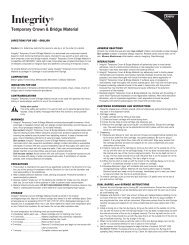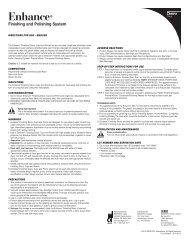Indirect and Direct Restorative Protocols - Caulk
Indirect and Direct Restorative Protocols - Caulk
Indirect and Direct Restorative Protocols - Caulk
Create successful ePaper yourself
Turn your PDF publications into a flip-book with our unique Google optimized e-Paper software.
› PRINCIPLES & PRACTICES<br />
Finishing <strong>and</strong> Polishing Composite<br />
Resin Restorations<br />
Clinical Parameters<br />
› Abstract:<br />
The use of composite resin<br />
restorations continues to<br />
increase as clinicians gain<br />
proficiency with state-ofthe-art<br />
dental materials<br />
<strong>and</strong> contemporary adhesive<br />
bonding techniques. In order<br />
to ensure optimal aesthetics<br />
in direct resin restoration,<br />
proper finishing <strong>and</strong> polishing<br />
procedures must be conducted.<br />
These clinical steps predispose<br />
the restoration for longterm<br />
performance <strong>and</strong> the<br />
patient for optimal oral health.<br />
Accordingly, selection of the<br />
appropriate instrumentation<br />
<strong>and</strong> use of sound operative<br />
principles as highlighted herein<br />
are imperative.<br />
Finishing <strong>and</strong> polishing composite<br />
resin requires a systematic<br />
approach to ensure an<br />
aesthetic outcome. Effective<br />
finishing <strong>and</strong> polishing of direct<br />
restorations is necessary not only for<br />
aesthetic purposes, but also to ensure optimum<br />
oral health. The accumulation <strong>and</strong><br />
retention of bacteria <strong>and</strong> plaque around<br />
composite restorations can be affected<br />
by the marginal finish, surface texture,<br />
<strong>and</strong> the integrity of the final restoration.<br />
If a smooth, well-polished surface is not<br />
achieved, this plaque accumulation can<br />
lead to chronic gingival inflammation,<br />
recurrent marginal decay, staining, <strong>and</strong><br />
restoration failure. The finishing <strong>and</strong> polishing<br />
of composite restorations also aids<br />
the clinician in establishing functional occlusion<br />
<strong>and</strong> contour. Devices for finishing<br />
<strong>and</strong> polishing include both cutting instruments<br />
(eg, multi-fluted carbide finishing<br />
burs) as well as abrasive finishing <strong>and</strong> polishing<br />
systems that will be used to successively<br />
refine restoration surfaces.<br />
Carbide burs are available in various<br />
sizes <strong>and</strong> utilized by the clinician to<br />
achieve natural tooth contours as well as<br />
to smooth restorative surfaces in advance<br />
of the polishing sequence:<br />
■ 12-fluted carbides—trimming <strong>and</strong><br />
contouring.<br />
■ 18-fluted carbides—successive finishing<br />
of surfaces.<br />
■ 30-fluted carbides—final finishing<br />
prior to polishing.<br />
Selection of the appropriate bur for a<br />
given clinical situation is dictated primarily<br />
by the required anatomy of the<br />
restoration. Embrasures, lingual regions,<br />
occlusal surfaces, <strong>and</strong> the various tooth<br />
shapes have differing contours that must<br />
be achieved during a finishing procedure.<br />
In this manner, longer shapes (eg,<br />
tapered, interproximal) are indicated for<br />
facial surfaces of anterior teeth or interproximal<br />
regions of canine <strong>and</strong> posterior<br />
teeth. Flame-shaped carbides are used for<br />
primary anatomy <strong>and</strong> round-end burs for<br />
contouring, whereas egg-shaped burs are<br />
Figure 1. Carbide fi nishing burs (Midwest ® Esthetic Finishing Burs,<br />
DENTSPLY Professional, York, PA) are ideal for refi ning margins <strong>and</strong><br />
obtaining optimal surface texture.<br />
Inset: The helical shape improves contact with the tooth surface.<br />
Figure 2. To provide a lasting surface luster with PoGo ® One Step<br />
Diamond Micro Polisher (DENTSPLY <strong>Caulk</strong>, Milford, DE), light pressure<br />
should be applied to the restoration surface.<br />
31
















